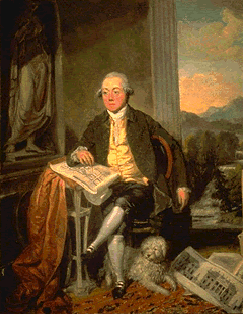James Craig

Click on the map held by Craig or on the drawing at his feet to zoom on it
Born into an Edinburgh merchant family, James Craig (1744-95) studied at the school founded in 1694 by the first accountant of the Bank of Scotland for the sons of poor merchants. He was then apprenticed to the Incorporation of the Wrights and Masons of Edinburgh, where exercises included among others the drawing of a Doric or Tuscan column after Palladio, and the plan and elevation of a house.
At twenty-two he won the competition for the development of the New Town.
His library contained works of architectural theory (Vitruvius, Alberti, Vignola, Palladio, in various editions and translations), handbooks of geometry, algebra, perspective, books on the five orders of architecture, some collections of archeological plates (among others on the recent discovery of Herculanum), and texts on town-planning.
This painting follows the tradition of portraiture in an architectural setting with curtains and an opening on to the landscape. Craig holds a pair of compasses in his hand and places it on a version of his design for the New Town.
In the background towards the right, in the opening marked by a fluted column, the landscape is inspired by the poem The Seasons (1730-40) by James Thomson, Craig’s uncle, a poet admired by the painter as well as by the sitter. To the left the neoclassical statue holding a garland is also that of a season, Spring.
The tripod on which the plan is placed is equally reminiscent of ancient models, and to the far right an obelisk can be glimpsed.
The elevation placed at his feet is that of the College of Physicians. The composition is balanced, the elevation and the plan being on the same oblique line from the lower right corner, counterbalanced by Craig’s contrapposto movement and by the folds of the carpet on the tripod.
The accessories as well as the composition are a classical manifesto.

